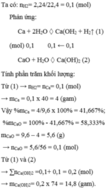Hãy nhập câu hỏi của bạn vào đây, nếu là tài khoản VIP, bạn sẽ được ưu tiên trả lời.

Bài tập của bạn hình như là sai số nên mk tính ko ra.
nH2 = 1,68/22,4 = 0,075 mol
Fe (0,075) + 2HCl ------> FeCl2 + H2 (0,075)
-Theo PTHH: nFe = 0,075 mol
=> mFe= 0,075 . 56 = 4,2 gam
=> mCu = 8 - 4,2 = 3,8 gam

\(2Na+2H_2O\rightarrow2NaOH+H_2\\ Na_2O+H_2O\rightarrow2NaOH\\ n_{H_2}=\dfrac{6,72}{22,4}=0,3\left(mol\right)\\ n_{Na}=2.0,3=0,6\left(mol\right)\\ a,m_{Na}=0,6.23=13,8\left(g\right)\\ m_{Na_2O}=26,2-13,8=12,4\left(g\right)\\b, n_{Na_2O}=\dfrac{12,4}{62}=0,2\left(mol\right)\\ n_{NaOH\left(tổng\right)}=n_{Na}+2.n_{Na_2O}=0,6+\dfrac{12,4}{62}=0,8\left(mol\right)\\ m_{c.tan}=m_{NaOH}=0,8.40=32\left(g\right)\\ c,m_{ddNaOH}=m_{hh}+m_{H_2O}-m_{H_2}=26,2+200-0,3.2=225,6\left(g\right)\\ C\%_{ddNaOH}=\dfrac{32}{225,6}.100\approx14,185\%\)

PTHH:
\(CuO+H_2\) \(\underrightarrow{t^o}\) \(Cu+H_2O\) \(\left(1\right)\)
\(Fe_2O_3+3H_2\) \(\underrightarrow{t^o}\) \(2Fe+3H_2O\) \(\left(2\right)\)
Số mol H2 là 0,6 mol
Gọi số mol H2 tham gia pư 1 là x mol \(\left(0,6>x>0\right)\)
Số mol H2 tham gia pư 2 là \(\left(0,6-x\right)mol\)
Theo PTHH 1:
\(n_{CuO}=n_{H_2}=x\left(mol\right)\)
Theo PTHH 2:
\(n_{Fe_2O_3}=\frac{1}{3}n_{H_2}=\left(0,6-x\right):3\left(mol\right)\)
Theo bài khối lượng hh là 40g
Ta có pt: \(80x+\left(0,6-x\right)160:3=40\)
Giải pt ta được \(x=0,3\)
Vậy \(n_{CuO}=0,3\left(mol\right);n_{Fe_2O_3}=0,1\left(mol\right)\)
\(\%m_{CuO}=\left(0,3.80.100\right):40=60\%\)
\(\%m_{Fe_2O_3}=\left(0,1.160.100\right):40=40\%\)
1)
PTHH: \(2Cu+O_2\) \(\underrightarrow{t^o}\) \(2CuO\)
x x
Gọi số mol Cu phản ứng là x mol ( x >0)
Chất rắn X gồm CuO và Cu
Ta có PT: 80x + 25,6 – 64x = 28,8
Giải PT ta được x = 0,2
Vậy khối lượng các chất trong X là:
\(m_{Cu}\) = 12,8 gam
\(m_{CuO}\) = 16 gam
2)
Gọi kim loại hoá trị II là A.
PTHH: \(A+2HCl\rightarrow ACl_2+H_2\)
Số mol \(H_2\)= 0,1 mol
Theo PTHH: \(n_A=n_{H_2}\)= 0,1 (mol)
Theo bài \(m_A\) = 2,4 gam \(\Rightarrow\) \(M_A\) = 2,4 : 0,1 = 24 gam
Vậy kim loại hoá trị II là Mg

Bài 1:\(PTHH:\)
\(Ca+2H_2O--->Ca(OH)_2+H_2\) \((1)\)
\(CaO+H_2O--->Ca(OH)_2 \) \((2)\)
\(a)\)
\(nH_2=\dfrac{1,68}{22,4}=0,075(mol)\)
Theo PTHH (1) \(nCa=nH_2=0,075(mol)\)
\(=> mCa=0,075.40=3(g)\)
\(=> mCaO=8,6-3=5,6(g)\)
\(b)\)
\(\%mCa=\dfrac{3.100}{8,6}=34,88\%\)
\(=>\%mCaO=100\%-34,88\%=65,12\%\)
\(c)\)
Theo PTHH (1) \(nCa(OH)2=nH_2=0,075(mol)\)\((I)\)
Ta có: \(nCaO=\dfrac{5,6}{56}=0,1(mol)\)
Theo PTHH (2) \(nCa(OH)_2=nCaO=0,1(mol)\) \((II)\)
Từ (I) và (II) => \(nCa(OH)_2 =0,075+0,1=0,175 (mol)\)
\(=> mCa(OH)_2 = 0,175.74=12,95(g)\)

PT: \(Fe_2O_3+3H_2\underrightarrow{t^o}2Fe+3H_2O\)
\(CuO+H_2\underrightarrow{t^o}Cu+H_2O\)
Giả sử: \(\left\{{}\begin{matrix}n_{Fe_2O_3}=x\left(mol\right)\\n_{CuO}=y\left(mol\right)\end{matrix}\right.\)
\(\Rightarrow160x+80y=40\left(1\right)\)
Ta có: \(n_{H_2}=\dfrac{14,56}{22,4}=0,65\left(mol\right)\)
Theo PT: \(n_{H_2}=3n_{Fe_2O_3}+n_{CuO}=3x+y\left(mol\right)\)
⇒ 3x + y = 0,65 (2)
Từ (1) và (2) \(\Rightarrow\left\{{}\begin{matrix}x=0,15\left(mol\right)\\y=0,2\left(mol\right)\end{matrix}\right.\)
\(\Rightarrow\left\{{}\begin{matrix}\%m_{Fe_2O_3}=\dfrac{0,15.160}{40}.100\%=60\%\\\%m_{CuO}=40\%\end{matrix}\right.\)
Bạn tham khảo nhé!

Đặt \(\left\{{}\begin{matrix}n_{Al}=x\\n_{Fe}=y\end{matrix}\right.\) ( mol ) \(\rightarrow m_{hh}=27x+56y=5,54\left(g\right)\) (1)
\(2Al+3H_2SO_4\rightarrow Al_2\left(SO_4\right)_3+3H_2\)
x 1,5x ( mol )
\(Fe+H_2SO_4\rightarrow FeSO_4+H_2\)
y y ( mol )
\(n_{H_2}=1,5x+y=\dfrac{3,584}{22,4}=0,16\left(mol\right)\) (1)
\(\left(1\right);\left(2\right)\Rightarrow\left\{{}\begin{matrix}x=0,06\\y=0,07\end{matrix}\right.\)
\(\left\{{}\begin{matrix}\%m_{Al}=\dfrac{0,06.27}{5,54}.100=29,24\%\\\%m_{Fe}=100-29,24=70,76\%\end{matrix}\right.\)

Ca+2H2O->Ca(OH)2+H2
0,075-----------------------0,075
nH2=1,68\22,4=0,075 mol
=>mCa=0,075.40=3g
=>%mCa=3\8,6.100=34,88%
=>%mCaO=65,12%